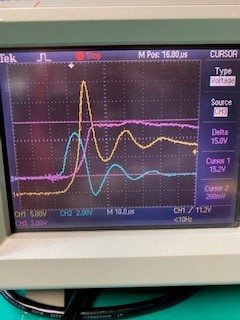Other Parts Discussed in Thread: BQ24133
I have an issue I am trying to track down and need some clarification on a few things regarding the BQ24133 chipset. below is a clip from the circuit I am trying to evaluate that was created by another person.
Question 1) from the below clip is the datasheet that mentions the output capacitance and inductance to keep the device in stability? What does this mean exactly? The circuit that I am evaluating has about 35µF output capacitance and 4.7µH output inductance and by equation 15 means f = 12.4 kHz. what implication will this have?
question 2) is the snubber circuit at the output inductor arranged correctly? I seem to believe the two components are swapped and wouldn't operate the correct way. ( is it even needed?)
question 3) there have been many boards that blow these IC chips for some reason. The hot swapping of the input ( AVCC) never gets above 20 VDC during the transient. To verify that the IC is blown, I probe the SW pin with a scope and see no oscillations. Sometimes the IC has a blown out spot in the lower right corner of the chip near PVCC and the SW pin. The charge current is set to 2A, and the battery voltage is 12.6 V. The stat pin is oscillating at 1 Hz so I know there is a fault but not sure what fault. I tried to diode check (on the board) the internal FET's which appears that the SW pin is shorted to ground indicating a bad FET. What could be causing this to happen. Also, another note of observation is that these chips during charging get almost too hot to touch and there is considerable amount of copper around it. ( enough where I couldn't get the chip off the board with heat on the bottom and top with heat guns). If AVCC is 14.4 then I-ripple is (14.4 *(9V/14.4V)*(1-(9V/14.4V)))/(1600kHz * 4.7µH) = 0.44A. from eq (11) on page 26 of the datasheet. Does this have implication?
Let me know your thoughts.
Thanks,
Justin


